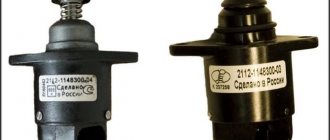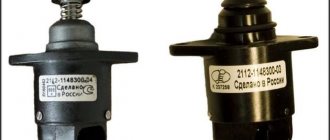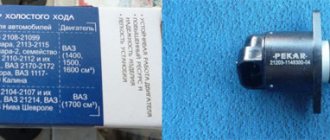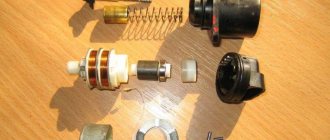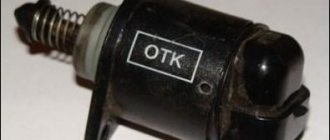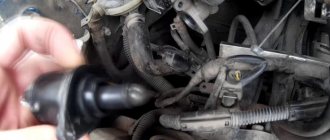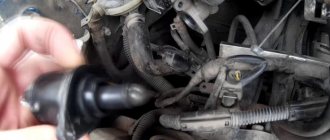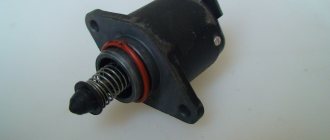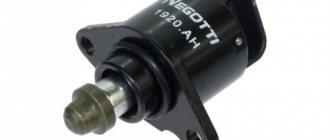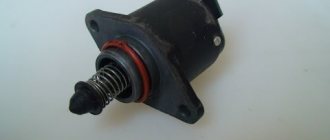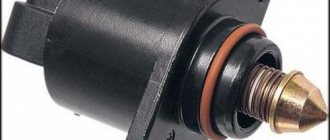Description of IAC
The idle speed control was installed only on Nivas with fuel injection and a mechanical throttle. When installing an electronic throttle, IAC is not used, since the entire IAC process is controlled electronically.
The regulator is designed to regulate engine speed at idle by adjusting the air supplied to the cylinder head. The IAC is a DC motor with a worm gear on the shaft, which has a cone installed that regulates the air supply through the IAC channel in the throttle assembly.
This sensor is quite unreliable, often subject to breakdown and replacement. Due to its unreliability, it was subsequently abandoned in favor of an electronic throttle.
Symptoms of a problem
The sensor is completely mechanical and if it breaks, the check engine warning light does not light up. A breakdown can be diagnosed only by the signs of an IAC malfunction, which are described below.
Signs:
- Spontaneous engine stop at idle;
- Stopping the engine when switching to neutral;
- There are no warm-up speeds on a cold engine;
- The revolutions are floating;
- Spontaneous increase and decrease in speed at idle;
All these signs indicate IAC only when they are detected at idle, since the regulator operates in idle mode and does not participate in the operation of the internal combustion engine at high speeds.
Symptoms and causes of IAC malfunction
Signs of a malfunctioning idle speed sensor appear as follows:
- during a cold start, the crankshaft speed does not increase, which is why the engine runs unstable and tends to stall;
- there is a drop in the number of idle revolutions after a significant increase in the load on the generator - turning on headlights, electric heaters, and so on;
- the engine periodically stalls when any gear of the manual transmission is switched off (the symptom manifests itself while driving);
- The speed “floats” - it spontaneously increases and decreases.
Important point! There is a misconception that a regulator failure is necessarily accompanied by the inclusion of the Check Engine indicator on the dashboard. Since the element is an actuator, the light warning option is not provided in all cars.
If the car shows signs of IAC malfunction in the form of floating engine speed at idle, advanced diagnostics may be needed. A spontaneous change in the crankshaft rotation speed occurs for many reasons - failure of a sensor, air leaks, gas distribution malfunctions, and so on. It is better to start troubleshooting by checking the regulator.
IAC failure occurs for three main reasons:
- Open or poor contact in the power supply circuit. Simply put, there are problems with the wiring.
- Breakdown of the stepper motor due to natural wear and tear. In this case, only replacing the idle speed sensor will help.
- Contamination of the rod and cone with oil deposits.
There is a fourth reason - problems with the electronic control unit.
The problem is quite rare and is accompanied by additional symptoms - increased gas mileage, unstable operation in all modes, difficult starting, and the like. Oil deposits reach the rod thanks to secondary gases sent by the crankcase ventilation system for re-combustion. The more worn out the engine, the more deposits accumulate on the working cone. As a result, moving the rod becomes difficult; in advanced cases, the mechanism simply jams.
Checking the IAC Niva
Checking this sensor to accurately identify its failure must be carried out in two ways: visual inspection and multitherm testing. Let's look at each of the checks in more detail.
Visual inspection
This check is carried out only after removing the IAC from the remote control.
It is necessary to check the condition of the regulator body; there should be no chips, cracks or gaps between the metal and plastic parts.
The presence of all rivets securing the plastic part of the sensor is checked, since the absence of a rivet may be accompanied by the passage of air.
Check the condition of the rubber sealing ring. There should be no burrs or cracks on it.
The mobility of the worm shaft is checked. He should move around without biting.
Check that there is no carbon deposits on the regulator cone.
Checking with a multimeter
Since the sensor is mechanical and, in principle, its design is based on a conventional DC motor, the test is carried out by measuring the resistance of the IAC winding.
To check on a multimeter, set the switch to measure a resistance of 200 ohms.
We connect the multimeter probes to the central terminals of the IAC and measure the resistance on them. The reading on the device screen should be close to 50 ohms. If the device shows 1 or infinity, then most likely a winding break has occurred.
If the winding breaks, the idle speed regulator VAZ 2121-2123 must be replaced with a new one.
Causes of failure. Node check
The reasons for the malfunction of the XX regulator are breaks in the electrical winding. engine and needle jamming due to dirt or corrosion. But the sensor is not always the “culprit” for missing idle speed. Therefore, before removing and checking the sensor, check its power supply circuit.
For all checks you will need a multimeter. The power circuit is checked with a device set to “voltmeter” mode. Diagnostics is simple - we disconnect the block with wires from the regulator, connect the “negative” probe of the multimeter to ground, and the positive one to the terminals marked with the letters “A” and “D”.
With the ignition on, we take measurements. If the circuit is working properly, the readings should correspond to the rated voltage of the circuit. If there is no voltage, you should check the computer and relays responsible for powering the sensor.
How does the idle speed sensor work on a Niva 21214 injector?
The regulator, idle speed sensor Niva-21214 injector is responsible for the cold start of the engine and its operation at low speeds when the gear is off. Previously, on carburetors, these functions were performed by 2 units: an air damper with a cold start membrane and an electric valve with an idle jet.
To some extent, diagnosing malfunctions was easier than after the advent of the electronic fuel control system. Nevertheless, if you wish, you can also understand it in order to detect problems with the regulator and fix them yourself.
Additional function of the regulator
An additional function of the device in question is to block the air flow in forced idle mode. This mode is activated when 3 conditions are met:
- the car is coasting;
- any gear is engaged;
- engine speed above 1800 rpm.
Under such conditions, it is impractical to supply the air-fuel mixture to the cylinders, since the car moves by inertia. So fuel will be wasted. Therefore, based on the damper and speed sensors, the controller stops the supply of fuel and air, giving the corresponding commands to the injectors and the idle speed controller. When the speed drops below 1800 rpm or the driver presses the gas pedal, the supply of the combustible mixture is resumed. If the driver switches the gearbox to the neutral position, the regulator opens the channel, and only idle speed is activated.
Replacing an element
Signs of failure of the idle speed element are very similar to the failure of the throttle position sensor, only in this case the “Check engine” display does not flash on the instrument panel. The car does not start well when cold, is unstable at idle and may stall when coasting. The regulator cannot be repaired; it only needs to be replaced.
The element is replaced in the following order:
- Disconnect all pipes from the throttle body, unscrew and remove this unit. Without this, dismantling the regulator is impossible.
- The element in the form of a barrel with a flange is screwed to the body with 2 screws. Unscrew them and pull out the regulator without losing the gasket.
- Measure the length of the rod on the new element, starting from the flange of the part; it should not exceed 23 mm. If the rod is longer, then you need to retract it, briefly applying a voltage of 12 V to the contacts marked “D” and “C”.
- Wipe the seat with a rag to remove dirt, lubricate the gasket with motor lubricant and install the new regulator in place.
After replacement, you need to install the throttle valve assembly back, connect the pipes and start the engine to check.
Source
Sensor diagnostic methods
The easiest way to check that the idle speed sensor is working is to start the engine and remove the power connector from the block. When the element is in good condition, the speed will drop sharply and the engine will stop - when the power supply is turned off, the spring will push the cone forward and the cross-section of the bypass channel will completely close. If the engine operation remains the same or changes slightly, move on to other testing methods.
The next stage of diagnostics is measuring the supply voltage, performed in this order:
- Disconnect the IAC connector and turn on the ignition.
- Using a voltmeter, measure the voltage at the corresponding contacts of the removed connector (in VAZ cars these are terminals marked A and D).
- If there is no voltage or does not reach 12 volts, you need to look for a problem in the electrical wiring. Otherwise, proceed to diagnosing the regulator itself.
Replacing the idle speed regulator VAZ 21214
The regulator, idle speed sensor Niva-21214 injector is responsible for the cold start of the engine and its operation at low speeds when the gear is off. Previously, on carburetors, these functions were performed by 2 units: an air damper with a cold start membrane and an electric valve with an idle jet.
To some extent, diagnosing malfunctions was easier than after the advent of the electronic fuel control system. Nevertheless, if you wish, you can also understand it in order to detect problems with the regulator and fix them yourself.
Element location and operating principle
In fact, the term "sensor" is not very suitable for the name of this element, since it does not measure any parameters. It is more correct to call the device the idle speed controller VAZ-21214. This is a small unit with a stepper motor built inside, to which a retractable rod is attached. At the end of the rod there is a spring-loaded valve in the form of a cone, whose task is to block the cross-section of the channel where the air moves.
As in carburetors, the operation of an engine with an injector at idle is ensured by a separate system, where the main role is played by a regulator controlled by a controller. The air supply control unit has a special channel that bypasses the throttle valve. That is, the Niva’s power unit idles with the throttle completely closed, while air enters the injector through the bypass. This is where the VAZ-21214 idle speed sensor is located; its task is to increase or decrease the air flow passing through the bypass at the command of the controller. To start a cold engine, it is always necessary to supply an enriched mixture to the cylinders, and as it warms up, gradually deplete it to normal. Previously, the issue was solved by closing the primary chamber using a damper, which caused a vacuum to arise in the manifold and the engine drew in more fuel.
We are looking for the reason why the idle speed on the VAZ 21214 floats
- The first thing I recommend paying attention to is the mass air flow sensor (MAF or flow meter). Read this article on how to check the mass air flow sensor.
- The second “suspect” usually becomes the idle air regulator (IAC), if after checking the flow meter you do not find anything, check the IAC.
- After this, inspect the wiring of the speed sensor (DS). Read how to check and replace the DS here.
- The next sensor that can cause floating idle speed is the crankshaft position sensor (CPS). The sensor itself is unlikely to have failed; most likely the reason is in the wiring or chip. If you don’t find anything strange in the wiring, check the DPKV.
- The throttle assembly can also often affect the idle speed, so it would be a good idea to check the TPS (throttle position sensor), as well as the throttle valve itself, it may need cleaning. How to clean the throttle valve I wrote here.
- Plugs, high-voltage wires and the ignition module can cause problems with idle, so first check the high-voltage wires, and then the spark plugs.
- Engine idle speed fluctuates often due to a faulty idle speed solenoid valve. To test this valve, remove power from it, then turn on the ignition and connect the power wire to the contact on the valve. In this case, you should hear a distinct click; if this does not happen, connect the wire to the contact that is connected to the “positive” terminal of the battery. Even if you do not hear a click, you can conclude that the valve is faulty. If there is a click, but the engine speed fluctuates as before, check its jet.
Among other things, check the condition of the air filter; it may need to be replaced. Make sure that the ignition system is working properly and that there are no air leaks.
If the tips and recommendations described above do not produce results or you are not sure that you can cope with such work, seek help from professionals; specialists will quickly and accurately determine the source of the malfunction and stabilize the floating idle speed of the engine.
Thank you for your attention, I will be glad if it helps someone. If you know other reasons or methods of verification, you can safely add to this article using the comment form. Until we meet again, take care of yourself and your car.
Didn't find the information you are looking for? on our forum.
We recommend reading:
- How to remove the catalyst on a VAZ 2114, as well as on a “classic”, “Kalina”, “Prior”, “Niva”
- How to check struts on a VAZ 2110
- VAZ 2114 valves knock when cold
- Gasoline consumption VAZ 2115 injector, city, highway, combined cycle
- How to check the oil pressure in a VAZ 2112 16 valve engine
- The dimensions on the VAZ 2110 are missing, the reason for how to repair it
- Replacing the throttle cable on a VAZ 2115
- How to install Euro handles on a VAZ 2107
How to check the sensor?
If you have a tester, checking is easy:
- Set the VAZ 2110 to the handbrake;
- Disconnect the IAC connector to check;
- Check the voltage of the VAZ 2110, 2112 sensor circuit, while connecting the “minus” to the engine, the “plus” to the removed block, namely to terminals A: D (marked on the block, you can see the diagrams);
- The ignition is turned on and the readings given by the idle speed regulator are checked, which should be about 12 V. The value will be less - most likely the battery is discharged. When there is no voltage, it is necessary to check the entire circuit, and then the electronic control unit. There are no malfunctions, which means the circuit is working - the IAC installed on VAZ 2112 engines and other modifications are checked;
- The tester terminals are connected to the block, the circuit is as follows - first to terminals A: B, then to C: D. The resistance should be within 53 Ohms;
- Next, pairs A: C, B: D are checked - in this case, the resistance on a working product will be infinitely large.
When, as a result of these checks, the sensor reveals a discrepancy in the readings, it should be replaced. Also, the inoperative state of these VAZ 2110, 2112 engine sensors, in the unscrewed position, can be checked by attaching a block to them, then you need to turn on the ignition.
When the power is connected to the working product, the rod with the needle will change position. No changes will occur on a broken sensor. If a breakdown of the idle air regulator is detected, of course, it must be repaired. But there is no need to rush to a car service center - you can do the repairs yourself, saving money and time. But first, in general, it is worth cleaning the IACs; often after this they return to “life”.
Additional function of the regulator
An additional function of the device in question is to block the air flow in forced idle mode. This mode is activated when 3 conditions are met:
Under such conditions, it is impractical to supply the air-fuel mixture to the cylinders, since the car moves by inertia. So fuel will be wasted. Therefore, based on the damper and speed sensors, the controller stops the supply of fuel and air, giving the corresponding commands to the injectors and the idle speed controller. When the speed drops below 1800 rpm or the driver presses the gas pedal, the supply of the combustible mixture is resumed. If the driver switches the gearbox to the neutral position, the regulator opens the channel, and only idle speed is activated.
Operating principle of the idle speed sensor.
The idle speed sensor, otherwise known as the regulator (IAC), allows you to select the optimal crankshaft speed depending on the specified conditions. If this part breaks down, the rhythm of the engine’s operation is disrupted, since a sufficient amount of air does not enter the combustion chamber, or a too lean mixture is formed, as a result of which the engine speed begins to float, this is especially noticeable at idle speed.
The principle of operation is as follows: the air mixture flow sensor (MAF) determines how much air has entered the combustion chamber, after which the electronics calculates how much fuel needs to be supplied to the injectors. The engine speed is read by the crankshaft sensor (CPS), and if this indicator is low, the IAC increases the air supply, simulating pressing the gas pedal.
On the Niva 2123, the idle speed control is made in the form of a small electric drive with a spring and a rod ending in the form of a needle, which are enclosed in one housing. The IAC is attached to the throttle body. The sensor starts working when the key is turned in the ignition switch. At this moment, the rod rests against a special hole to count the necessary steps, after which the valve returns to its original position.
The speed sensor for Niva 21214 is based on the action described by physicist Hall. It reads electromagnetic pulses, which are then processed by the on-board computer. One kilometer of travel is equal to 6000 pulses sent by the DS, and if the speed increases, the frequency of the pulses increases. As a result, calculations occur in a special controller, which provide information to the instrument panel in a more convenient form.
And also interesting: Niva Chevrolet instrument panel designations. Improving the Chevrolet Niva dashboard
Engine operation at idle
Operating the engine at the lowest speeds is a very difficult mode for it. It’s worth starting with the fact that fuel and air are supplied very slowly into the combustion chamber, therefore, the formation of the mixture is ineffective. It is also worth considering that there is very little pressure in the engine intake manifold, so it is possible for exhaust gases to flow back into the combustion chamber. From this we can conclude that there is a decrease in efficiency, an increase in exhaust toxicity, and excessive wear of the elements of the cylinder-piston group. It is worth noting that the device does not have a very high price. The idle speed regulator costs about 400-500 rubles.
Replacing an element
Signs of failure of the idle speed element are very similar to the failure of the throttle position sensor, only in this case the “Check engine” display does not flash on the instrument panel. The car does not start well when cold, is unstable at idle and may stall when coasting. The regulator cannot be repaired; it only needs to be replaced.
The element is replaced in the following order:
- Disconnect all pipes from the throttle body, unscrew and remove this unit. Without this, dismantling the regulator is impossible.
- The element in the form of a barrel with a flange is screwed to the body with 2 screws. Unscrew them and pull out the regulator without losing the gasket.
- Measure the length of the rod on the new element, starting from the flange of the part; it should not exceed 23 mm. If the rod is longer, then you need to retract it, briefly applying a voltage of 12 V to the contacts marked “D” and “C”.
- Wipe the seat with a rag to remove dirt, lubricate the gasket with motor lubricant and install the new regulator in place.
After replacement, you need to install the throttle valve assembly back, connect the pipes and start the engine to check.
Cleaning DXX
You cannot ignore such a basic procedure as cleaning - this can give results, since sometimes parts of the product, contacts, become coked, covered with dirt and oil.
What you need for cleaning:
- cleaner (lubricant) WD-40 or similar cleaning products for equipment;
- cotton wool, clean rags, tampons.
- The sensor is completely dismantled, with the block disconnected.
- The swab is moistened with the cleaning mixture. You can also spray the product with an aerosol.
- Carefully wipe the contacts, needle, and installation sites, especially if oil is found there.
Before installation, the regulator is dried, the protrusion of the needle from the body is measured (the norm is 23 mm).
If the sensor has a malfunction of the electrical part - the winding, the electric motor - then repair is impractical or impossible. They buy a new product, especially since it is not too expensive (on average 500–700 rubles, but can be found for 250–300 rubles).

